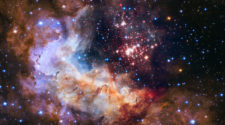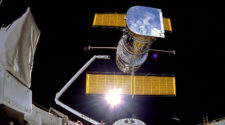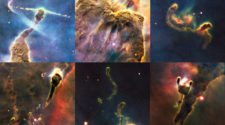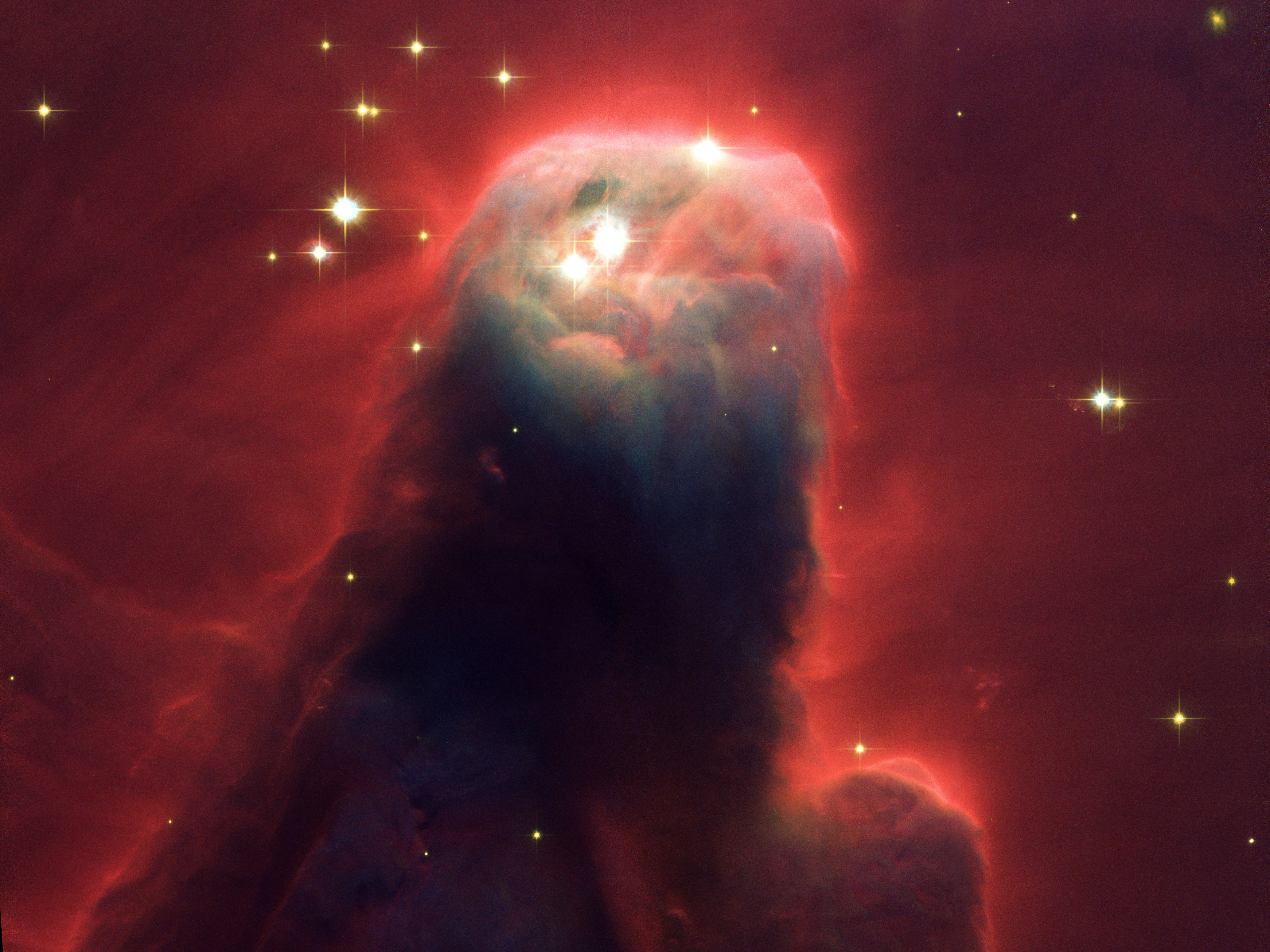
21. Ghostly star-forming pillar of gas and dust
Resembling a nightmarish beast rearing its head from a crimson sea, this celestial object is actually just a pillar of gas and dust. Called the Cone Nebula (in NGC 2264) this monstrous pillar resides in a turbulent star-forming region. This picture shows the upper 2.5 light-years of the Cone.
Radiation from hot, young stars (located beyond the top of the image) has slowly eroded the nebula over millions of years. Ultraviolet light heats the edges of the dark cloud, releasing gas into the relatively empty region of surrounding space. There, additional ultraviolet radiation causes the hydrogen gas to glow, which produces the red halo of light seen around the pillar.
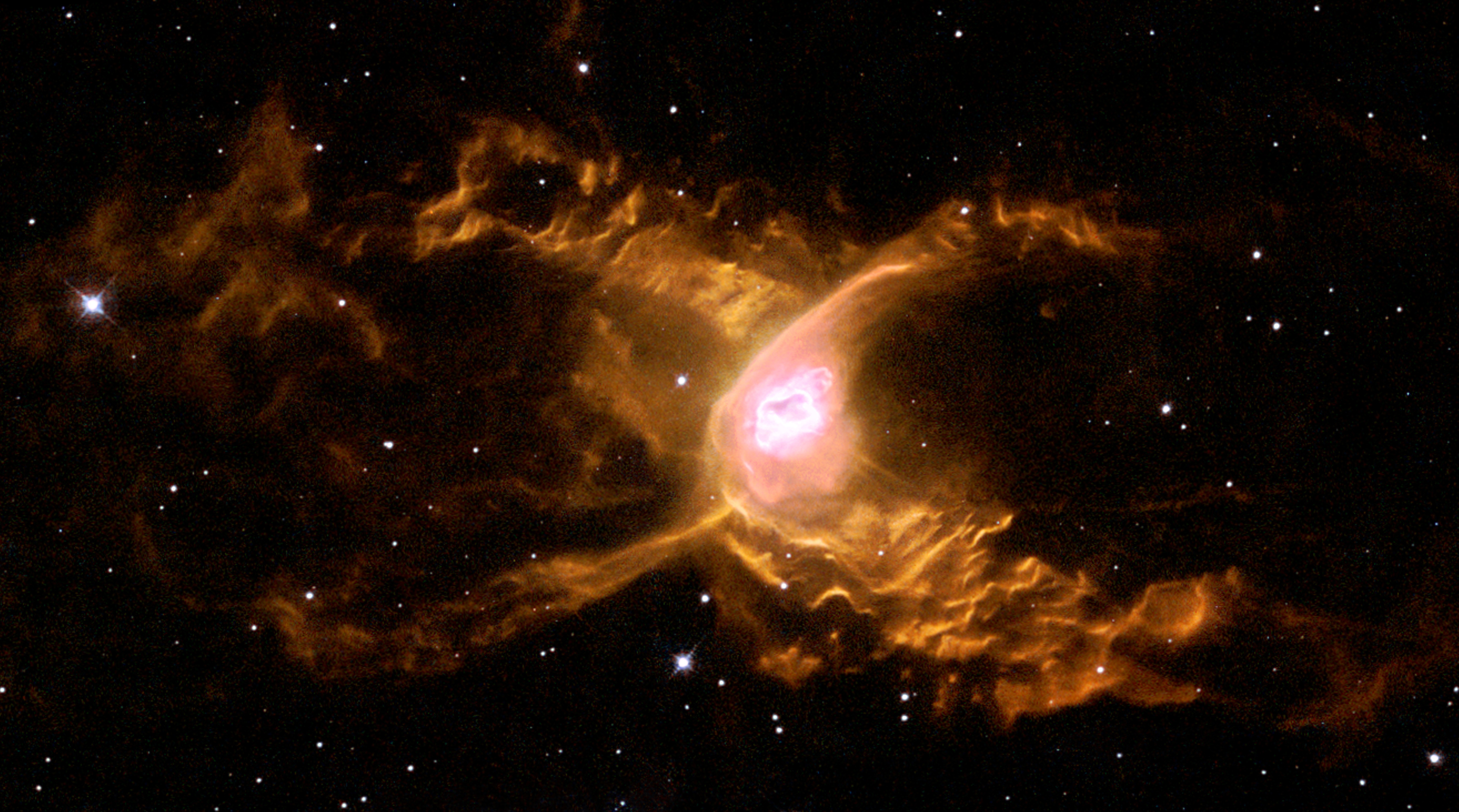
22. Red Spider Nebula
Huge waves are sculpted in this two-lobed nebula some 3000 light-years away in the constellation of Sagittarius. This warm planetary nebula harbours one of the hottest stars known and its powerful stellar winds generate waves 100 billion kilometres high. The waves are caused by supersonic shocks, formed when the local gas is compressed and heated in front of the rapidly expanding lobes. The atoms caught in the shock emit the spectacular radiation seen in this image.
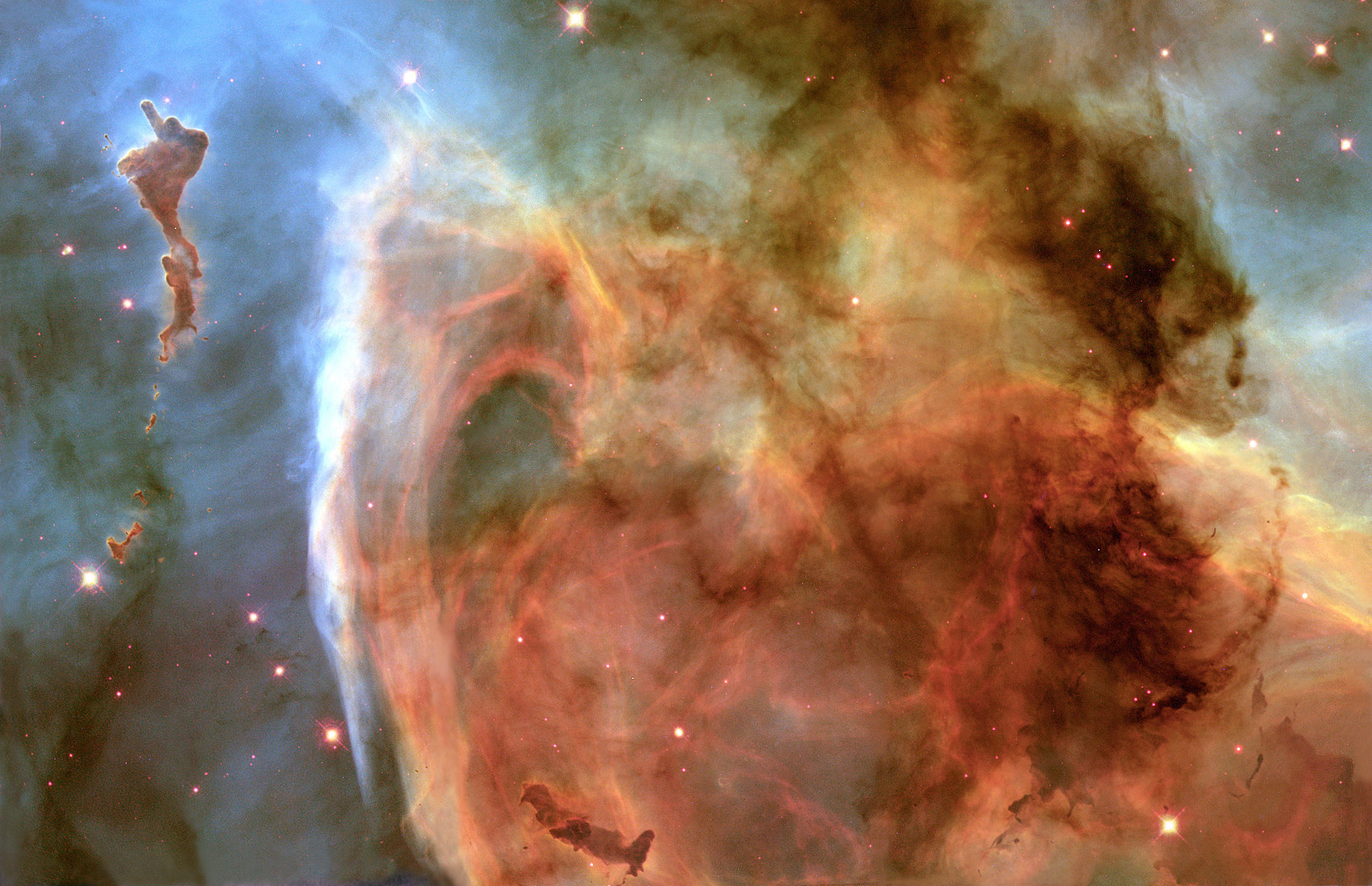
23. Light and shadow in the Carina Nebula
Previously unseen details of a mysterious, complex structure within the Carina Nebula (NGC 3372) are revealed by this image of the ‘Keyhole Nebula.’. The picture is a montage assembled from four different April 1999 telescope pointings with Hubble’s Wide Field Planetary Camera 2, which used six different colour filters. The picture is dominated by a large, approximately circular feature, which is part of the Keyhole Nebula, named in the 19th century by Sir John Herschel. This region, about 8000 light-years from Earth, is located adjacent to the famous explosive variable star Eta Carinae, which lies just outside the field of view toward the upper right. The Carina Nebula also contains several other stars that are among the hottest and most massive known, each about 10 times as hot, and 100 times as massive, as our Sun.
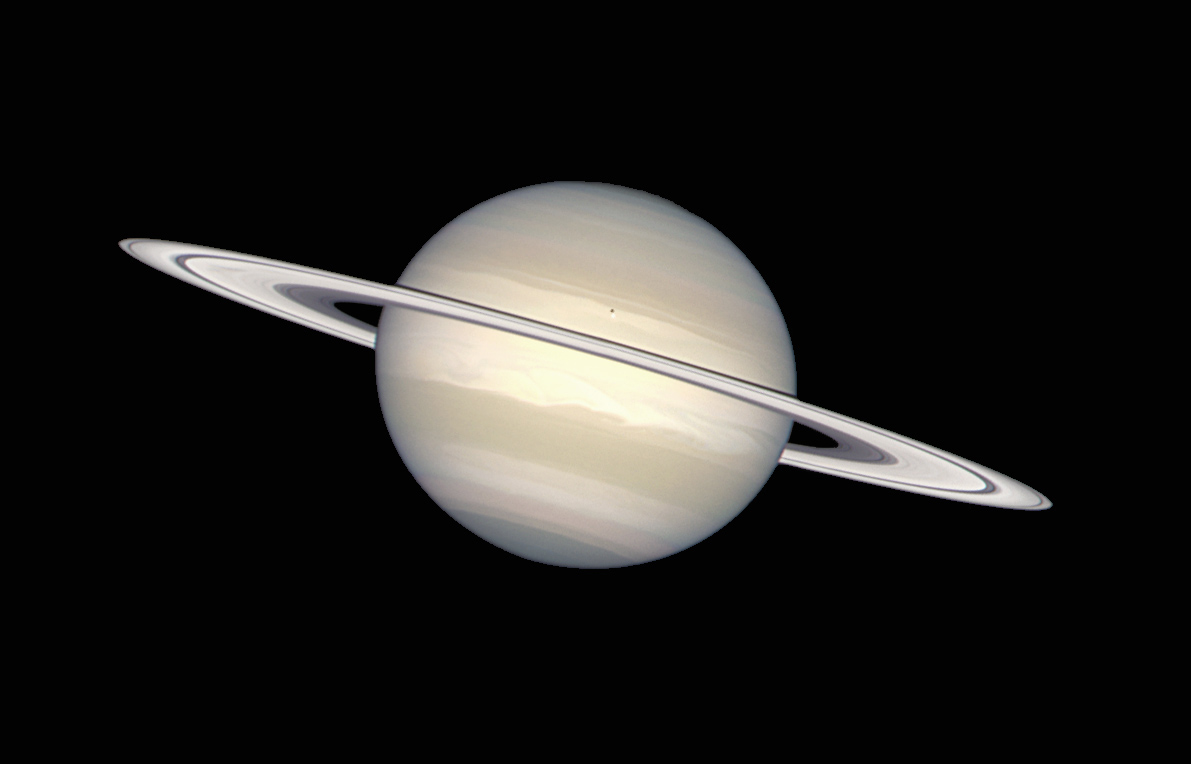
24. Saturn in natural colours
The ring swirling around Saturn consists of chunks of ice and dust. Saturn itself is made of ammonia ice and methane gas. The little dark spot on Saturn is the shadow from Saturn’s moon Enceladus.
Hubble has provided images of Saturn in many colors, from black-and-white, to orange, to blue, green, and red. But in this picture, image processing specialists have worked to provide a crisp, extremely accurate view of Saturn, which highlights the planet’s pastel colors. Bands of subtle colour – yellows, browns, grays – distinguish differences in the clouds over Saturn, the second largest planet in the solar system.
“Hubble has three key attributes that have allowed it to make significant contributions to solar system science: ultraviolet (UV) capability, high spatial resolution, and longevity.
“Hubble’s ultraviolet spectroscopic capabilities enable unique views into the auroral activity in the solar system, and have also enabled quantitative studies of the atmospheres of planets, exospheres (extremely thin atmospheres) of moons, and compositions of comets. Recently, auroral studies of Jupiter’s moon Ganymede revealed the presence of a briny ocean of liquid water under its thick icy surface. A very exciting UV result from Hubble was the detection of a sporadic plume in the southern region of Jupiter’s moon Europa, made of the components of water. NASA continues to study this in preparation for the Europa Clipper mission, which will map out the icy crust of Europa in detail.
“Hubble’s high spatial resolution and longevity have been critical for the study of the distant giant planets in our solar system. Hubble has been one of the key missions for exploring the dynamics and cloud activity on the distant ice giants Neptune and Uranus. Hubble demonstrated that Neptune’s deep blue Great Dark Spots are a short-lived phenomena — 5 years, compared with Jupiter’s Great Red Spot which has lasted for hundreds of years. Hubble’s longevity did reveal, however, that Jupiter’s Great Red Spot is not static, and in fact has been shrinking steadily over that past two deacdes. Uranus, too, occasionally revealed a Great Dark Spot to Hubble’s sharp vision. Other significant solar system results from Hubble include the amazing images of Jupiter’s response to the impacts of comets such as Shoemaker-Levy 9 and the anonymous asteroid that hit in 2009. Hubble has seen other asteroids disintegrate, and comets swirling tails. Hubble has revealed dozens of binary Kuiper Belt Objects, discovered new rings around the planet Uranus.
“Hubble supports planetary missions. One of Hubble’s large programs provided detailed UV study of Saturn’s aurorae to complement in situ measurements being made by the Cassini spacecraft. Hubble’s high-resolution imaging provided detailed maps of Mars, especially its weather system, providing global context for the missions that roam Mars’ surface. Hubble discovered several possible Kuiper Belt Objects that are targets for the New Horizons spacecraft’s post-Pluto mission phase. Hubble provided pre-encounter maps of the asteroids Ceres and Vesta for the DAWN spacecraft.”
Dr. Jim Green
Planetary Science Division Director
NASA Headquarters
Washington, D.C.
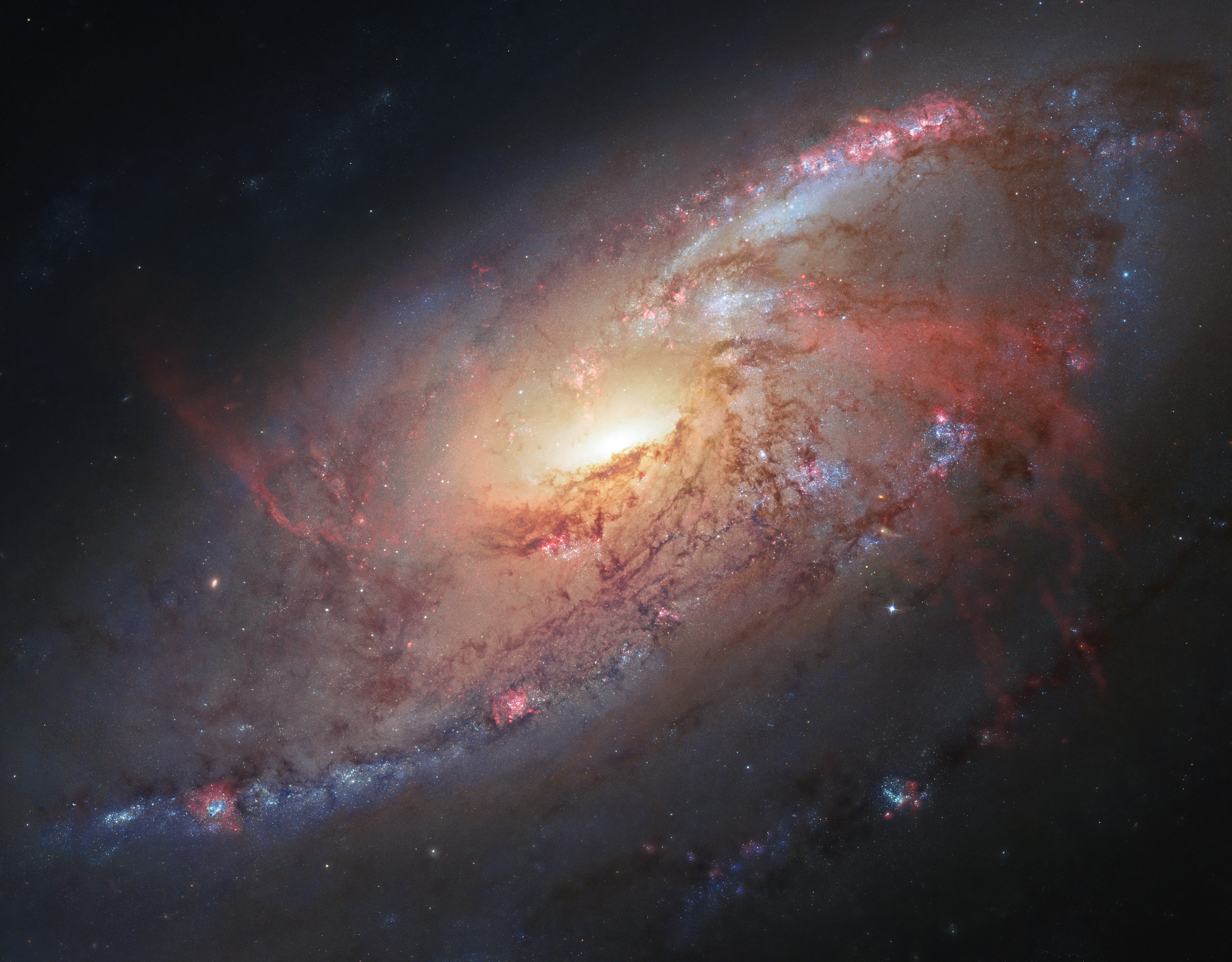
25. Stunning view of M106
This image combines Hubble observations of galaxy M106 with additional information captured by amateur astronomers Robert Gendler and Jay GaBany. Gendler combined Hubble data with his own observations to produce this stunning colour image.
M106 is a relatively nearby spiral galaxy, a little over 20 million light-years away.
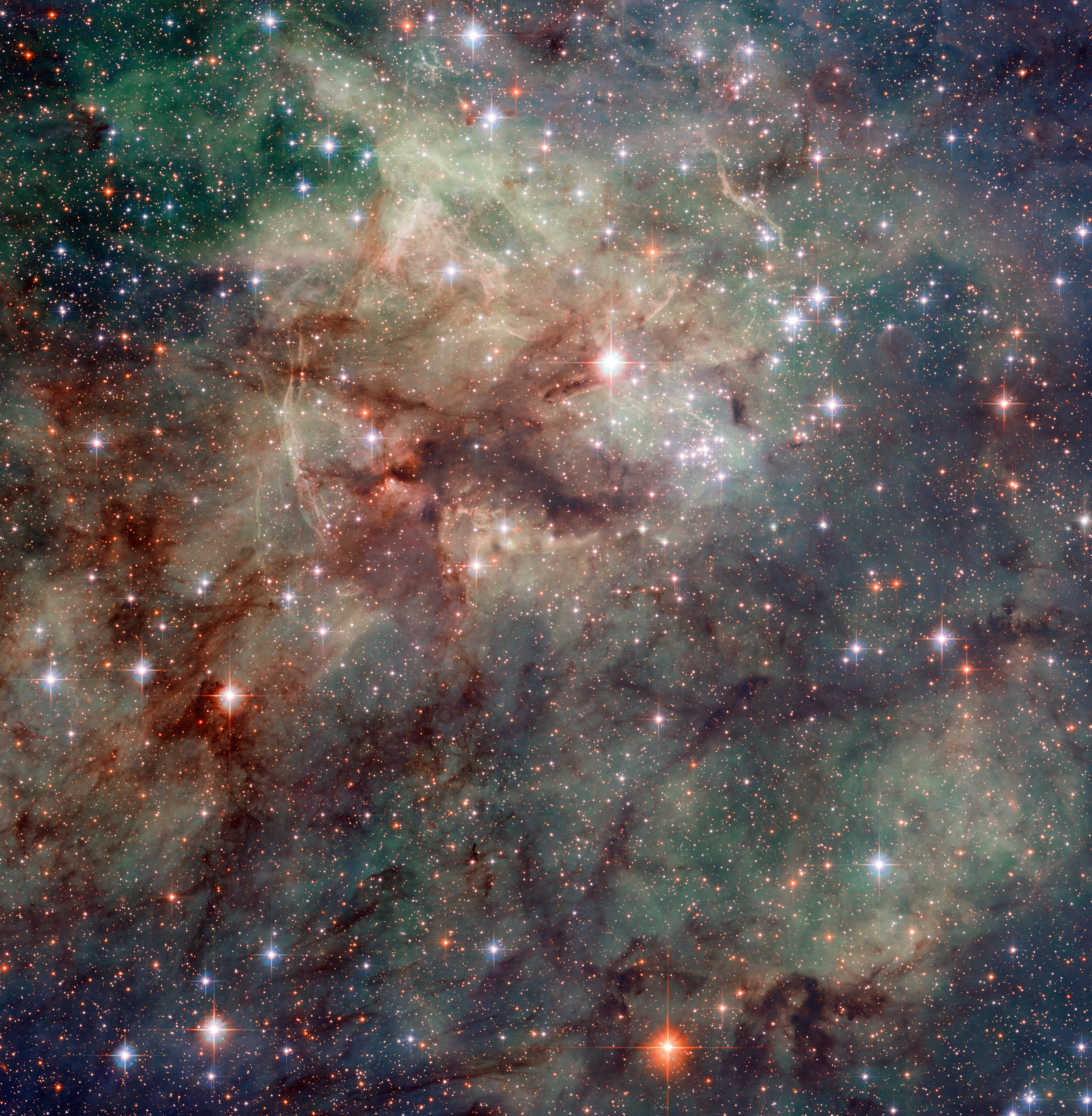
26. Hubble snaps close-up of the Tarantula Nebula
Hubble has taken this stunning close-up shot of part of the Tarantula Nebula. This star-forming region of ionised hydrogen gas is in the Large Magellanic Cloud, a small galaxy which neighbours the Milky Way. It is home to many extreme conditions including supernova remnants and the heaviest star ever found. The Tarantula Nebula is the most luminous nebula of its type in the local Universe.
“This region is called the Tarantula Nebula (cause the dust filaments on an image with a simple telescope have the appearance of the arms of a spider). At the very heart of the nebula sits a star cluster that is hosting many massive stars, several of them, as we now know are a few hundred times the mass of our Sun, much larger than was widely assumed. At the moment we are using one of the spectrographs (an instrument that unravels the light into different wavelengths to truly reveal the scientific data imprinted in the light) to study the properties of these extreme beasts in the center of the nebula in a program lead by P. Crowther. We would like to know if they are single stars, or maybe they are binaries.
“We want to know if they rotate like normal stars do. We want to know what chemical elements we see at their surface. We want to know how they radiate. We want to know about the strong winds they blow of their surface. And all these questions together will teach us how these massive stars live their lives, how they play their role as cosmic engines. How did such stars over the history of the cosmos change the pristine Universe left after the big bang into the modern universe in which we live today? I am fascinated and maybe a little obsessed to understand these massive stars, because they are key to understanding an important piece in the big question about our cosmic origin: how did we get here?”
Dr. Selma E. de Mink
Assistant Professor
University of Amsterdam
Netherlands
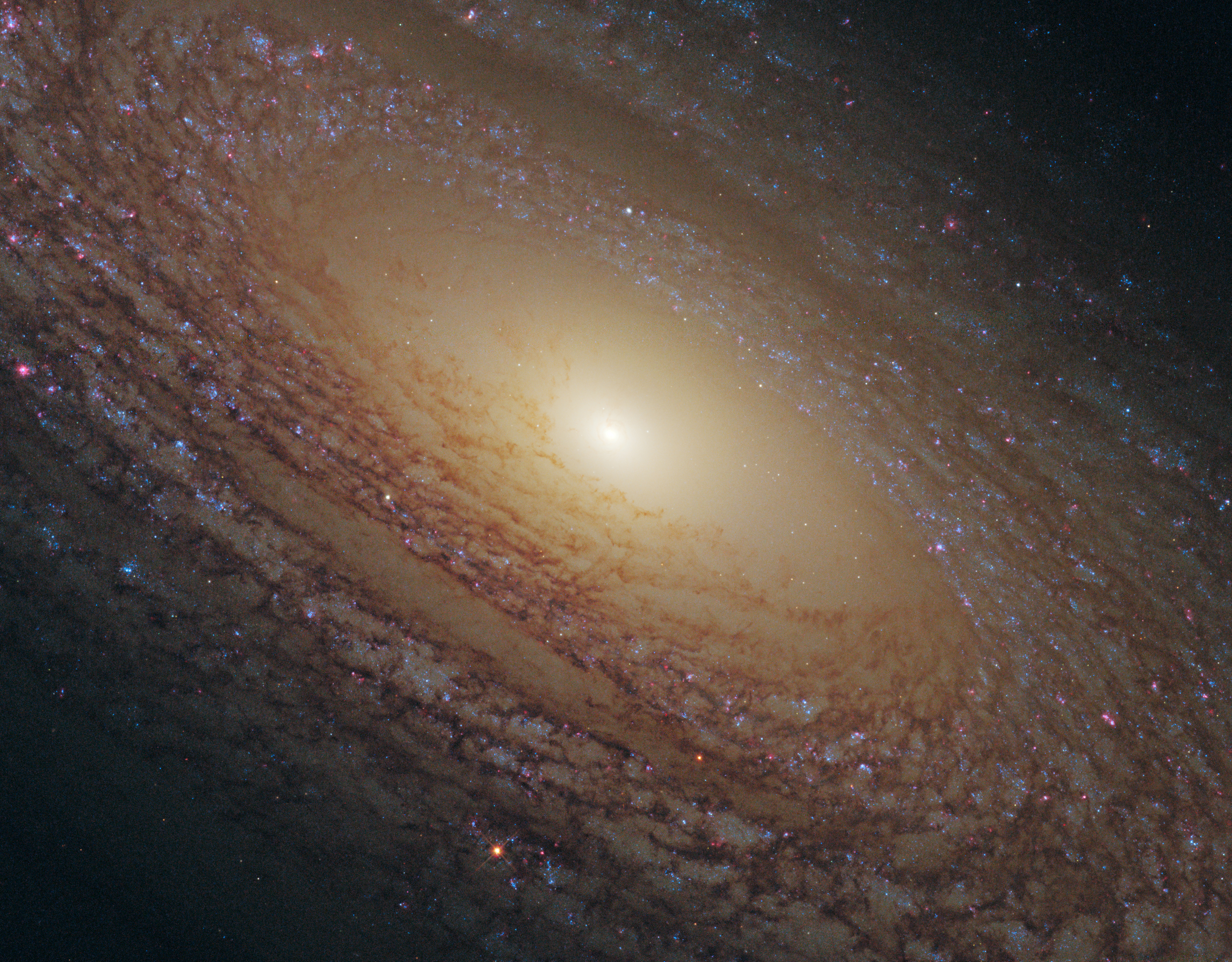
27. Flocculent spiral NGC 2841
Star formation is one of the most important processes in shaping the Universe; it plays a pivotal role in the evolution of galaxies and it is also in the earliest stages of star formation that planetary systems first appear.
Yet there is still much that astronomers don’t understand, such as how do the properties of stellar nurseries vary according to the composition and density of gas present, and what triggers star formation in the first place? The driving force behind star formation is particularly unclear for a type of galaxy called a flocculent spiral, such as NGC 2841 shown here, which features short spiral arms rather than prominent and well-defined galactic limbs.
“Hubble has revolutionized our understanding of the structures of distant galaxies. By working with Hubble data, I have continued to be surprised by the new and unexpected discoveries that result.”
Dr. Katherine E. Whitaker
NASA Postdoctoral Program Fellow
Goddard Space Flight Center
Greenbelt, Maryland
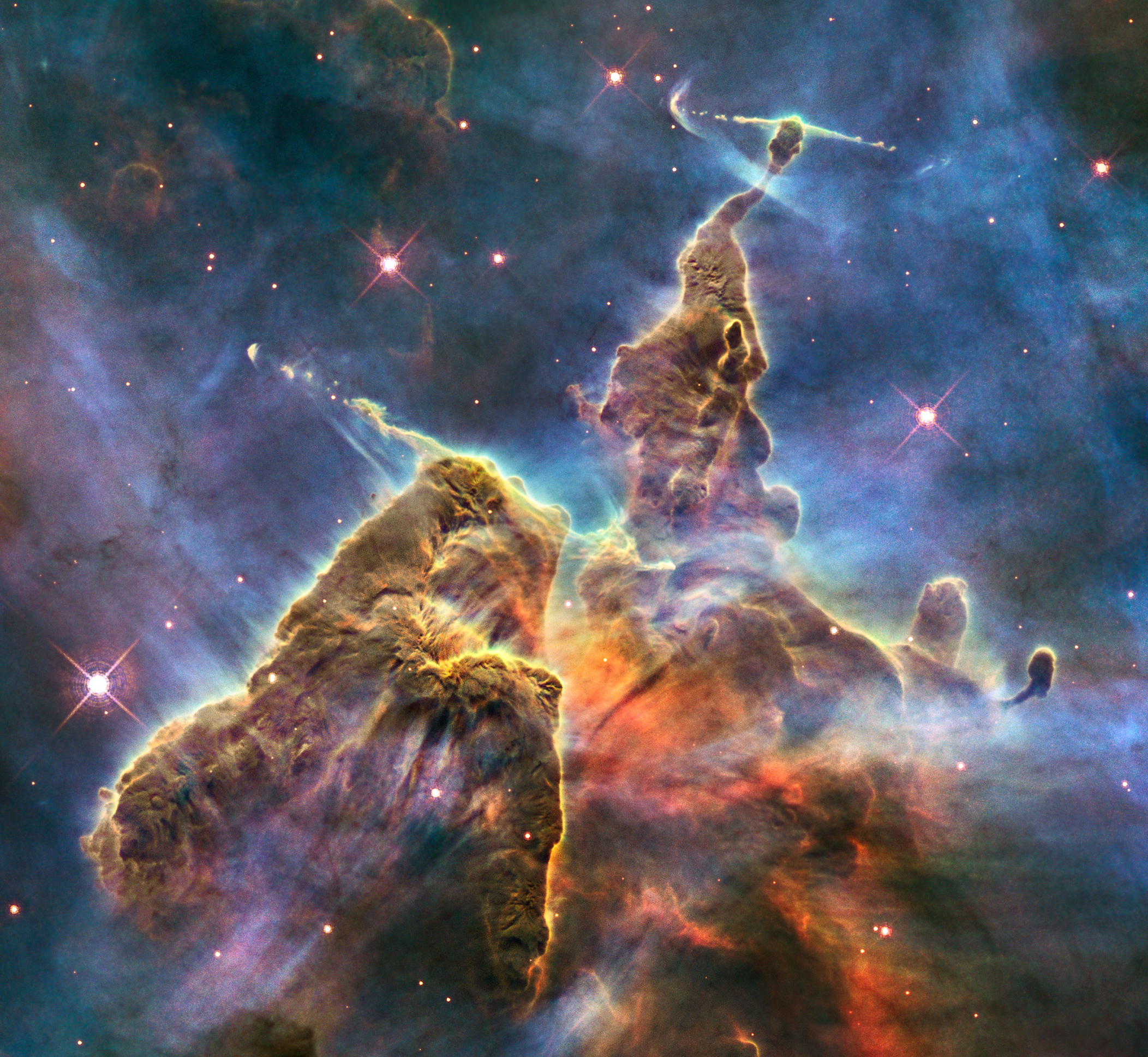
28. Hubble captures view of ‘Mystic Mountain’
This craggy fantasy mountaintop enshrouded by wispy clouds looks like a bizarre landscape from Tolkien’s The Lord of the Rings. This Hubble image, which is even more dramatic than fiction, captures the chaotic activity atop a pillar of gas and dust, three light-years tall, which is being eaten away by the brilliant light from nearby bright stars. The pillar is also being assaulted from within, as infant stars buried inside it fire off jets of gas that can be seen streaming from towering peaks.
This turbulent cosmic pinnacle lies within a tempestuous stellar nursery called the Carina Nebula, located 7500 light-years away in the southern constellation of Carina. The image celebrates the 20th anniversary of Hubble’s launch and deployment into an orbit around the Earth.
Scorching radiation and fast winds (streams of charged particles) from super-hot newborn stars in the nebula are shaping and compressing the pillar, causing new stars to form within it. Streamers of hot ionised gas can be seen flowing off the ridges of the structure, and wispy veils of gas and dust, illuminated by starlight, float around its towering peaks. The denser parts of the pillar are resisting being eroded by radiation.
Nestled inside this dense mountain are fledgling stars. Long streamers of gas can be seen shooting in opposite directions from the pedestal at the top of the image. Another pair of jets is visible at another peak near the centre of the image. These jets, (known as HH 901 and HH 902, respectively, are signposts for new star birth and are launched by swirling gas and dust discs around the young stars, which allow material to slowly accrete onto the stellar surfaces.
Hubble’s Wide Field Camera 3 observed the pillar on 1-2 February 2010. The colours in this composite image correspond to the glow of oxygen (blue), hydrogen and nitrogen (green), and sulphur (red).
“I’m part of a generation of astronomers that grew up surrounded by Hubble images, and I can safely say that they were a big part of the reason why I became an astronomer. Of course, having my college physics classes across the street from the Space Telescope Science Institute (ground zero for Hubble) didn’t hurt, either.”
Dr. Heather Knutson
Assistant Professor of Planetary Science
California Institute of Technology
Pasadena, California
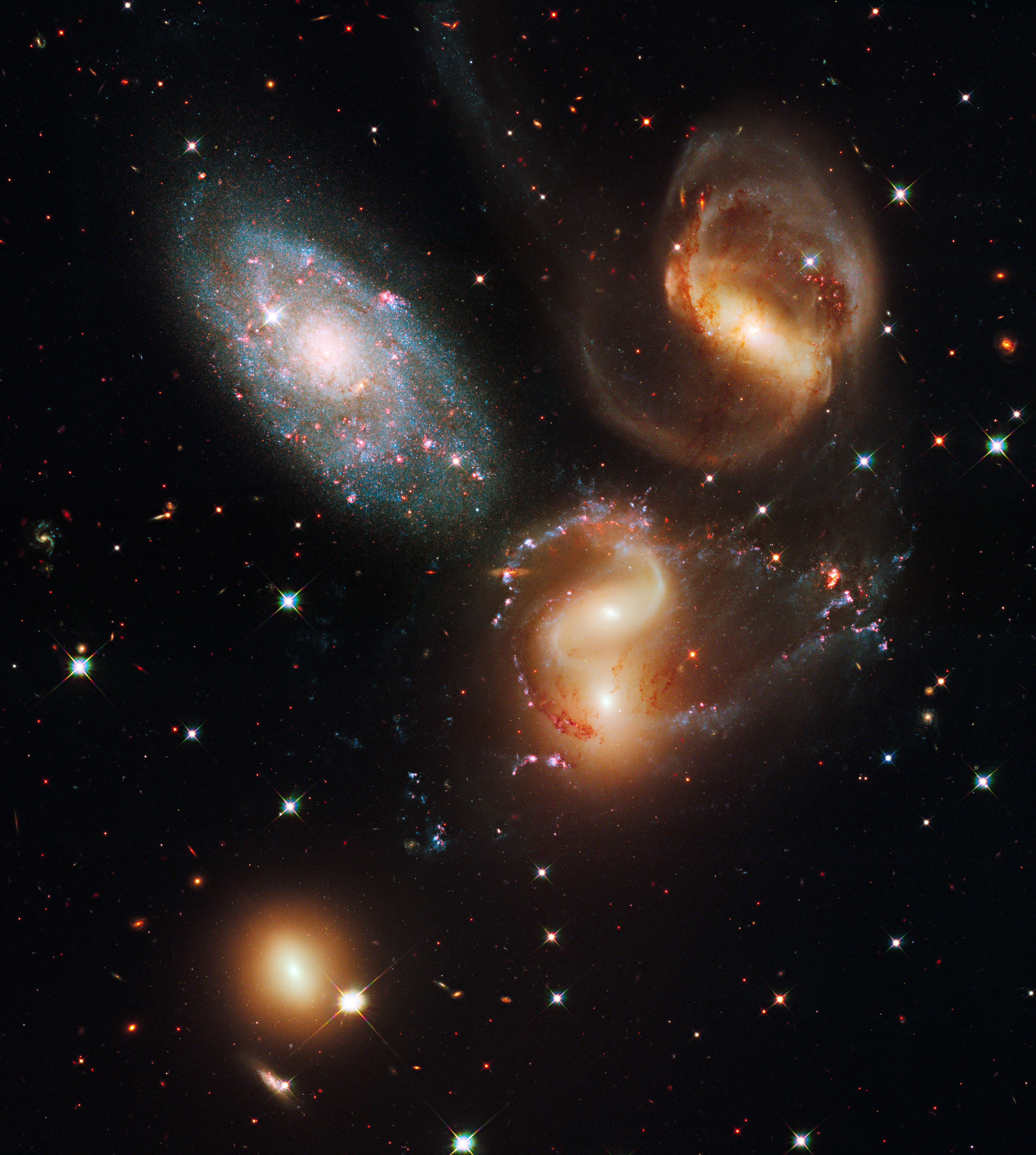
29. Galactic wreckage in Stephan’s Quintet
A clash among members of a famous galaxy quintet reveals an assortment of stars across a wide colour range, from young, blue stars to aging, red stars.
This portrait of Stephan’s Quintet, also known as the Hickson Compact Group 92, was taken by the new Wide Field Camera 3 (WFC3) aboard Hubble. Stephan’s Quintet, as the name implies, is a group of five galaxies. The name, however, is a bit of a misnomer. Studies have shown that group member NGC 7320, at upper left, is actually a foreground galaxy that is about seven times closer to Earth than the rest of the group.
Three of the galaxies have distorted shapes, elongated spiral arms, and long, gaseous tidal tails containing myriad star clusters, proof of their close encounters. These interactions have sparked a frenzy of star birth in the central pair of galaxies. This drama is being played out against a rich backdrop of faraway galaxies.
The image, taken in visible and near-infrared light, showcases WFC3’s broad wavelength range. The colours trace the ages of the stellar populations, showing that star birth occurred at different epochs, stretching over hundreds of millions of years. The camera’s infrared vision also peers through curtains of dust to see groupings of stars that cannot be seen in visible light.
NGC 7319, at top right, is a barred spiral with distinct spiral arms that follow nearly 180 degrees back to the bar. The blue specks in the spiral arm at the top of NGC 7319 and the red dots just above and to the right of the core are clusters of many thousands of stars. Most of the Quintet is too far away even for Hubble to resolve individual stars.
Continuing clockwise, the next galaxy appears to have two cores, but it is actually two galaxies, NGC 7318A and NGC 7318B. Encircling the galaxies are young, bright blue star clusters and pinkish clouds of glowing hydrogen where infant stars are being born. These stars are less than 10 million years old and have not yet blown away their natal cloud. Far away from the galaxies, at right, is a patch of intergalactic space where many star clusters are forming.
NGC 7317, at bottom left, is a normal-looking elliptical galaxy that is less affected by the interactions.
Sharply contrasting with these galaxies is the dwarf galaxy NGC 7320 at upper left. Bursts of star formation are occurring in the galaxy’s disc, as seen by the blue and pink dots. In this galaxy, Hubble can resolve individual stars, evidence that NGC 7320 is closer to Earth. NGC 7320 is 40 million light-years from Earth. The other members of the Quintet reside about 300 million light-years away in the constellation Pegasus.
Spied by Edouard M. Stephan in 1877, Stephan’s Quintet is the first compact group ever discovered.
WFC3 observed the Quintet in July and August 2009. The composite image was made by using filters that isolate light from the blue, green and infrared portions of the spectrum, as well as emission from ionised hydrogen.
“Without Hubble, our state of understanding of the Universe would have huge gaps where we’d have no real idea, especially in the ultraviolet region of the spectrum. In other areas of astronomy, we might be only 10 years behind where we are now.”
Dr. Bradley M. Peterson and Dr. Gisella De Rosa
(Peterson) Professor and Chair of Astronomy, Ohio State University, Columbus, Ohio
(De Rosa) Visiting Astronomer, Space Telescope Science Institute, Baltimore, Maryland
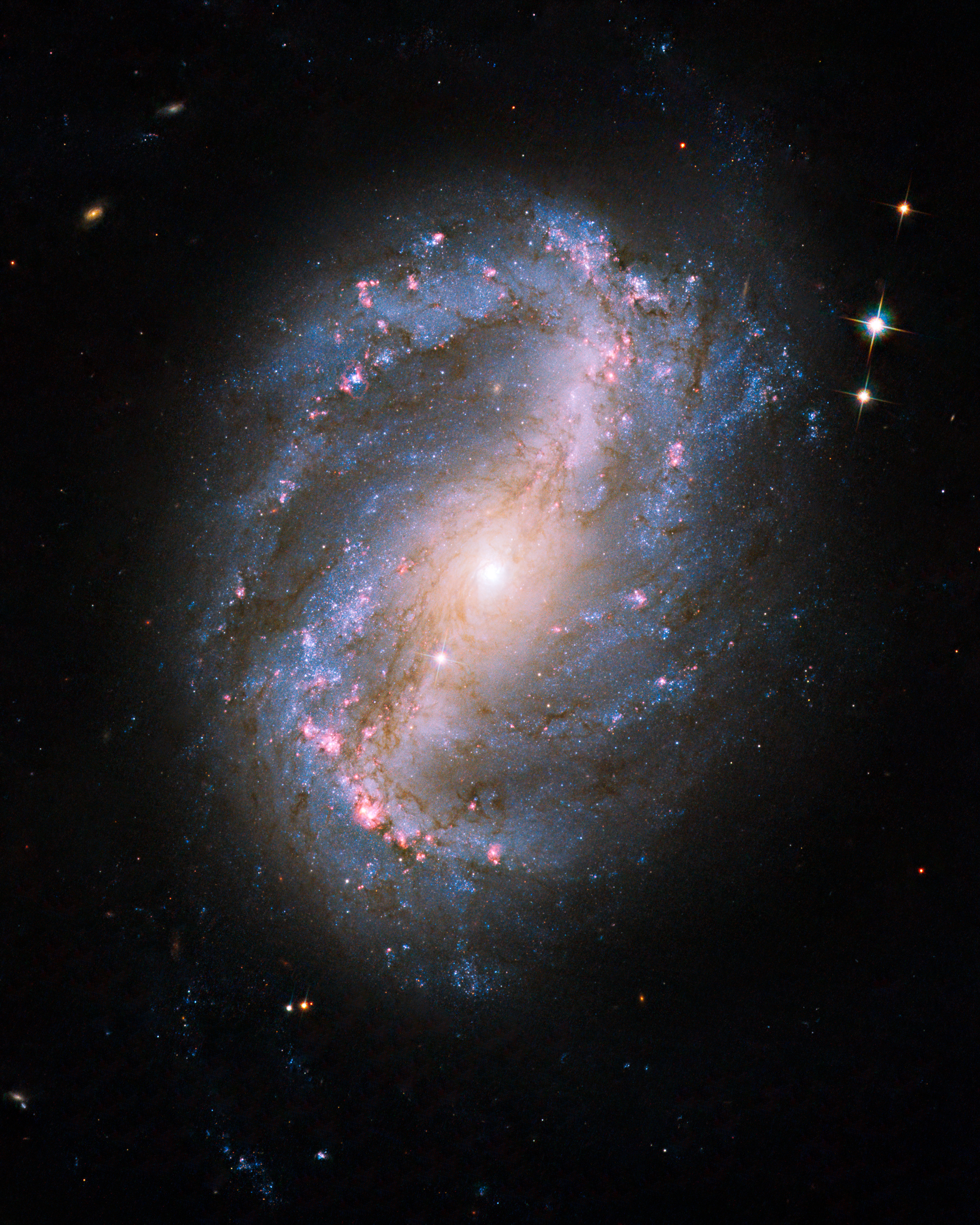
30. Barred spiral galaxy NGC 6217
This is the first image of a celestial object taken with the then newly repaired Advanced Camera for Surveys. The camera was restored to operation during the STS-125 Servicing Mission.
The barred spiral galaxy NGC 6217 was photographed on 13 June and 8 July 2009, as part of the initial testing and calibration of Hubble’s ACS. The galaxy lies up to 90 million light-years away in the north circumpolar constellation Ursa Major.

